
We are celebrating 15 years — and counting — of stories that are deeply researched and deeply felt, that build a historical record of what the city has been.
We are celebrating 15 years — and counting — of stories that are deeply researched and deeply felt, that build a historical record of what the city has been.
From time to time, our Omnibus columnists check in to provide commentary on issues of design, policy, and history and their impact on the life and form of the city today. Stephen Rustow’s first column scaled the heights of New York’s skyscrapers to consider “The Privatization of Prospect.” Here, in his second installment, Rustow looks at three intangible forces that greatly influence the shape of our built environment: zoning, finance, and the building code. Based in regulation or market fluctuation, each code has a discrete history and objective, and, as Rustow points out, its own distinctive language. Below, Rustow discusses how these variations in parlance become physical and encourages greater appreciation of the codes’ powerful and intertwined influence on urban form. – V.S.
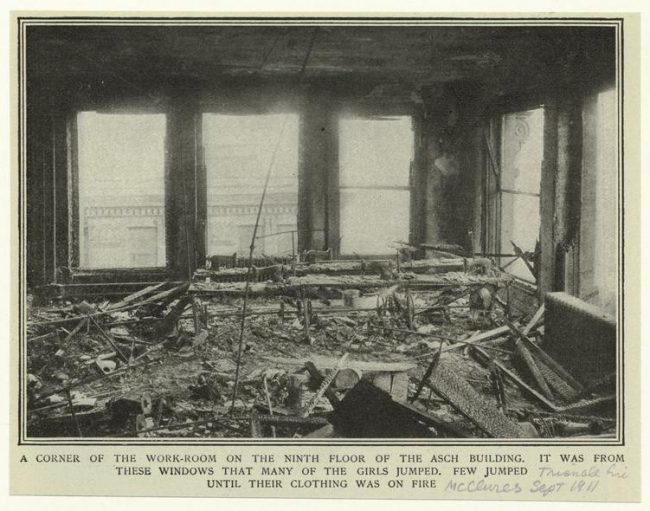
Interior of the Triangle Shirtwaist Factory after the fire, 1911 | Image via NYPL
The physical potential — the material essence — of any given city is set by zoning, finance, and building codes. And while these are not the only determinants of urban form, together they establish a framework for how cities grow and what they actually look like. Each code is a complex set of prescriptions that operates within a particular domain; as codes, zoning, finance, and building regulations all categorize certain urban conditions and specify a range of acceptable outcomes or necessary consequences. Codes are dynamic, invisible forces in cities, balanced block by block and decade after decade in an uneasy equilibrium of aspiration, calculation, and fear.
Zoning applies planning theory to the urban future. Understood as a code, zoning postulates a set of desired outcomes based on the use of land and the density of its occupation. The zoning code’s limits on height and bulk, its directives on setbacks and alignments, and its inducements to create connections and open space all delineate a kind of idealized city that reflects the prescriptive equilibrium of each generation’s planning orthodoxy. Thus zoning is an aspirational force that attempts to project on the messy urban reality some organizing image of what the city might become.
Finance, by contrast, represents the mechanics of development where profit points and bottom lines are the ultimate arbiter on what actually gets built. While arguably less “codified” than the other two forces, financing nevertheless applies to real estate a local and highly specific set of formulae derived from a continuous evaluation of opportunity and risk weighted against return. In recent decades, financing for urban development has been gradually resituated in a vast web of international capital flows, and investment on any particular street corner now competes with returns on cocoa harvests in Africa and mutual funds bankrolling tech start-ups. Yet investors with surplus capital have always been attracted to the presumed security of owning real estate to hedge other risks (and with cyclical regularity, have been proved wrong).
If zoning is sketched in watercolor or charcoal and financing counts in red and black ink, building codes are written in blood.
The building code is the dense thicket of texts that dictates how buildings are actually built. This is a code in the most fundamental sense, where the regulations that govern any given design ambition are explicitly spelled out. Such codes may be prescriptive — specifying quite literally the pieces and products of which a building can be made — or performative, imposing an outcome or minimum standard to be achieved without specifying the means to achieve it.[1] But in either case, they reflect a constantly evolving social consensus transcribed into statements about the legal obligations of urban buildings to those who use them.
A distinct and varied history determines the place of each of these codes in contemporary urban development. Zoning emerges in the US at the end of the 19th century in a curious fusion of City Beautiful aesthetics and the Progressives’ program for social reform.[2] But the history of zoning-like practices goes back to the Parisian places of Henri IV and the 17th century expansion of Turin where public space was designed by royal mandate, creating what was essentially a stage set of an ideal city and inciting private economic activity to complete the three-dimensional reality.[3] The history of urban financing mechanisms also reflects this alternation between government spending and private development, and while public expenditure may often lead to a more direct expression of urban ideals, it is private, speculative investment that becomes the normative engine of growth in New York City.[4] Finally, modern building codes date to London’s Building Act of 1844, although the Code of Hammurabi of four millennia earlier contained the first recorded laws governing buildings, even if these were less a set of rules than a list of penalties for flawed construction; it was not the building but the punishment that was codified.[5]
Codes are artifacts of language, expressed in a body of texts, yet zoning, finance and building codes all employ a distinct rhetoric: it is these texts, with their characteristic tone and vocabulary that most clearly reveal the meaning of each code in the larger web of urban form-making.
The zoning code, despite chapters of description, is first and foremost a densely layered plan or map — a representation of the ideal city — and it shares with other architectural drawings a graphic syntax. But this map is in turn a cipher for a three-dimensional image of the city, which all the prescriptions on density, height, bulk, use, alignments, and setbacks are intended to call into being. This image may accompany the plan, as with Jules Guerin’s exquisite watercolors that gave substance to Burnham’s 1909 Plan of Chicago, or it may come later, as in Hugh Ferris’ evocative 1922 charcoal studies that interpreted the possible variations that New York City’s zoning amendment of 1916 had legislated.[6]
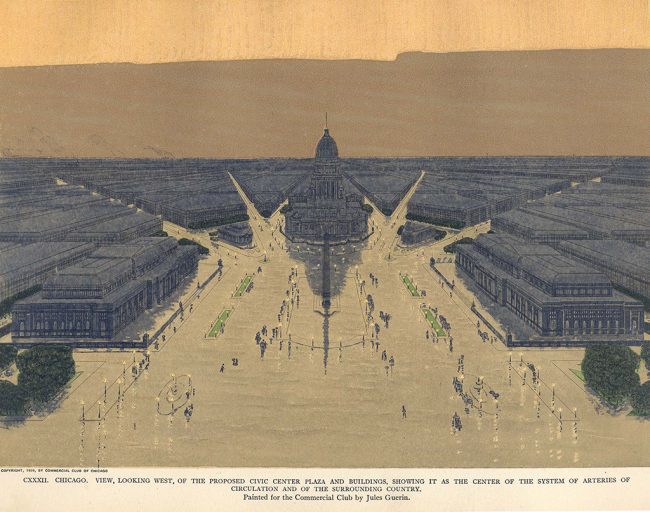
Jules Guerin’s watercolor illustrating Civic Center Plaza in Daniel Burnham’s Plan of Chicago | Image via Wikimedia Commons
The code of financial calculation is inevitably numerical, however the proverbial bottom line also conjures up a very particular physical result. Developers build to an ever-shifting formula of “economic height,” an elaborate algorithm that tries to identify the point of inflection just before diminishing returns make a marginally taller or bulkier building less profitable. The result of this simultaneous equation with multiple variables fixes a project’s profit (or loss), and any given building can be considered a snapshot of a fluid formula at a given moment.
The Empire State Building is a perfect example of just how such pure calculation can determine form as effectively as any zoning clause. The project for the building we know today was born when a luckless developer defaulted on an earlier, 2 million-square-foot, 50-story mixed-use plan for the same site. The banker who held the underlying mortgage then formed a small consortium of investors to explore how the project and its program might be revised to produce an acceptable return. The evaluation was entirely based on a half-page arithmetical exercise summarizing land costs, expenditures for materials and labor, and taxes and other expenses, all balanced against a mortgaging strategy that compared the projected income on a 55- versus 80-story building. It concluded in favor of the latter. Not one sketch or plan was drawn; indeed, architects weren’t even hired until the program, budget, materials, and construction schedule were fixed. Combined with the market-driven acceptable depth of a rentable floor-plate, the form-giving calculus — the financing code — of the Empire State was a fait accompli, awaiting only its translation into construction documents.[7]
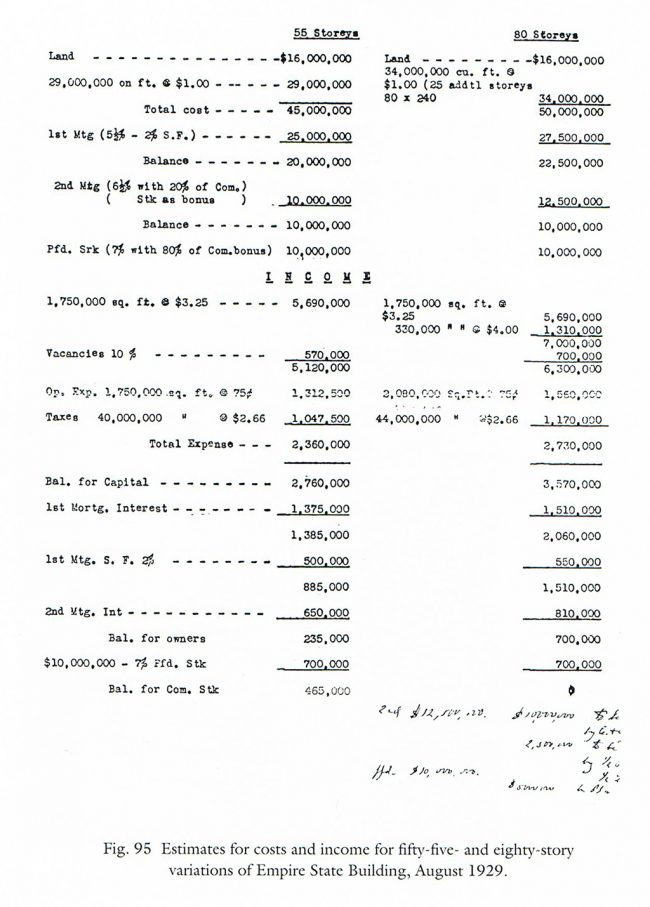
Cost and income estimates for the future Empire State Building | Image via Form Follows Finance by Carol Willis, p. 92
In contrast to the formal imagery of zoning codes and the numerical calculus of financing, the rhetoric of the building code is expressed in an actual text, a compendium of rules, requirements, and conditions, written in careful, legalistic prose intended to compel certain spatial relationships without unduly constraining use or architectural expression. Indeed the building code is conveyed exclusively as text; applying it to the design of actual buildings requires translation from the written to the three-dimensional — from word to form — and the correlation can never be direct. This “necessary interpretation” is the code’s saving grace, lest all buildings of a given type be reduced to the same identical diagram.[8]
The code’s elaborate strictures are confining: in specifying the size of rooms, the length of corridors, the width of exits, and the height, depth, and number of steps in stairs, the code forces all but the most resistant efforts into a familiar mold, one that architects sometimes assert has a deadening effect on innovation. Furthermore, the code’s language is so intricate that interpretation is often limited to a class of specialists, private consultants who work with architects to vet their plans “against code” and city inspectors who check for “code compliance,” pushing designers even further from any possibility of invention.
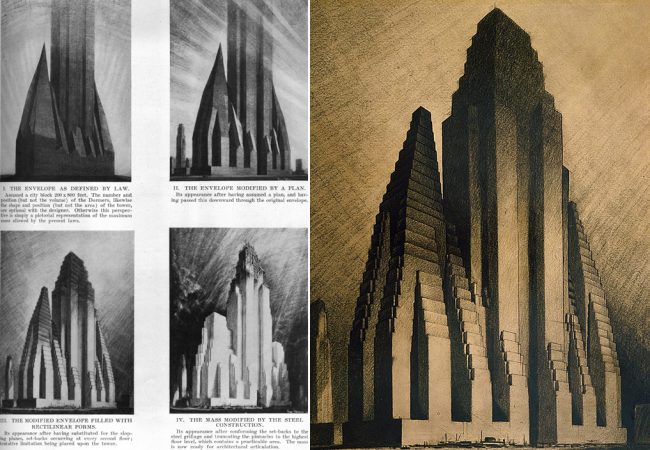
Hugh Ferris’s charcoal drawings interpreting possible building variations legislated by New York City’s zoning amendment of 1916
But if zoning is sketched in watercolor or charcoal and financing counts in red and black ink, building codes are written in blood. The code is a reactive text and each of its clauses is a response to some past disaster. Its awkward poetics is tragic in the original sense of the word, combining pity and fear in a dirge that eulogizes the deaths of those lost to fire, collapse, and malignant neglect. It is a muted language that stifles a cry of despair, hoping to forestall what can never be entirely foreseen.[9]
There are hundreds of examples, but the most compelling is certainly the Triangle Shirtwaist fire of 1911. The deadliest industrial disaster in local history, it killed 146 garment workers, most of them women and girls as young as 14, all of them recent immigrants crowded at sewing machines on three loft floors.[10] The fire itself was horrifically intense, spreading quickly through piles of cloth scraps. Many victims succumbed to flames and smoke before they could leave their worktables. But scores of other deaths were attributable to the building’s design and subsequent abuses: an exterior fire escape that tore away from the façade and collapsed under the weight of those who piled onto it; an inaccessible stair, locked by company foremen; an open elevator shaft, which channeled drafts that fanned the flames, creating a 9-story pit of fallen victims pushed by the panicked crowds behind them; and the height of the building itself, which exceeded by several stories the length of firemen’s ladders, leaving all those huddled at top floor windows with the gradual, terrible understanding that the only way to escape being burned alive was to jump to a certain death.
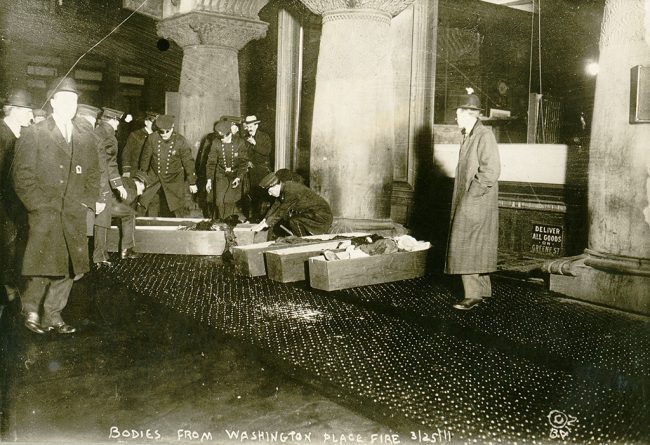
Victims of the Triangle Shirtwaist fire are placed into coffins on the street. | Photo via Wikimedia Commons
Had New York had Hammurabi’s code at the time — based on a principle of strict “damage symmetry,” property for property, limb for limb, life for life — the owners and designers of the building would have seen their own children burned alive or thrown from windows.[11] But there was no code in place. The building’s owners were charged only with having barred the door to the stair and, claiming ignorance of how it had come to be locked, were excused by a jury and ordered to pay damages of $60 per victim (which they later appealed).
The horror of the fire gave rise to the first comprehensive laws that would eventually become the City’s high-rise building code. By 1912, New York had enacted legislation requiring automatic sprinklers in some industrial buildings and regulated both the enclosure of elevator shafts and the disposal of factory waste. Other laws mandated protected access and egress, fireproofing of building materials, and the installation of fire extinguishers and alarms.[12] Finally, the American Society of Safety Engineers was founded in response to the tragedy, dedicated to the principle that a systematic improvement of New York’s buildings could be designed into the city’s future.
The incantatory regulations of building code are a kind of magical thinking, a prayer for “protected space” and a way out of chaos.
But such optimism was thwarted by an endless parade of fires and building collapses in cities across the country: 1929, the Rhythm Club, Natchez, 209 dead; 1942, Cocoanut Grove, Boston, 492 dead; 1946, the Winecoff Hotel, Atlanta, 119 dead; 1949, St. Anthony’s Hospital, Effington, IL, 70 dead; 1963, Golden Age Nursing Home, Fitchville, OH, 63 dead; 1980, MGM Grand, Las Vegas, NV, 85 dead; 1990, Happy Land, Bronx, NY, 87 dead; 2003, the Station Nightclub, West Warwick, RI, 100 dead. Each of these, and scores of others, added its measure of suffering and regret, while fostering yet another set of post hoc changes to the building code.[13]
The code’s impact on urban buildings is enormous. Fully 20 to 30% of a building’s cubic footage, depending on its height and configuration, is code-mandated space, an invisible realm within the building’s greater volume that has no prescribed use unless and until disaster strikes. Of course, no code can prevent fire or collapse, but that is not finally the intent: the code seeks only to carve out a fragile path through space that endures, we hope, for a prescribed lapse of time, just long enough to escape. The incantatory regulations of building codes are thus a kind of magical thinking, a prayer for “protected space” and a way out of chaos.
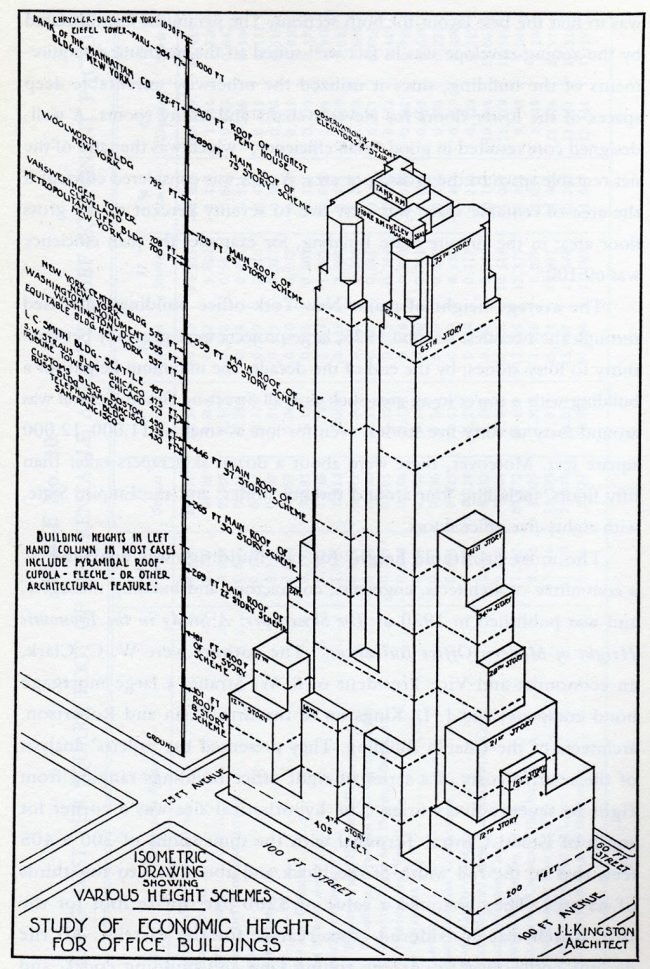
Study of the “economic height” for an office building as applied to the Empire State Building project | Image via J.L. Kingston and W.C. Clark’s The Skyscraper
Zoning, finance, and building codes operate together in a shifting dynamic that constantly redefines their aggregate effect; the shape of any given city block reflects their particular balance at a given moment. Moreover, each code gradually modifies the others. Changes in zoning create changes in value: New York’s original 1916 resolution had mapped enough potential space to house a population of 55 million, and this theoretical bulk was only revised downward in 1961.[14] In the ‘70s and ‘80s the residential zoning of loft buildings changed Soho and TriBeCa from derelict industrial areas to some of the New York’s wealthiest neighborhoods. And the recent up-zoning in Midtown Manhattan has created Central Park views on streets where none existed and astonishing value in narrow tracts of land that banks would previously have considered undevelopable.
But changes in financing mechanisms also shift the balance among the other codes: state-sponsored fiscal incentives, tax breaks, and the like all augment or diminish the efficacy of zoning statutes as, historically, did illegal red-lining by lenders. Similarly, when banks first bundled mortgages as collateral for credit default swaps, the prescriptive rationale underlying residential zoning codes across the county was suddenly imperiled so that Detroit, for example, now wonders what zoning modifications might effectively compensate for a radically diminished landscape of urban value. Changes to the building code also gradually percolate through both financing and zoning, subtly adjusting the development formula for “economic height.” With every code rewrite, each changed egress dimension, newly rated material, or added safety feature revises the developer’s bottom line and shifts the calculus of what is profitable to build (which in turn adds new pressures on zoning to adapt to these redefined potentials in real estate values).
If speculative development is the default engine of city form-making — at least in the globalized, late-capitalist version of urbanism — then zoning and building codes may be understood as constraints on market processes. But each also has a deeper resonance. The zoning code shapes the exterior of city blocks, making a public claim on public space and creating incentives that harness capital in the service of some practical urban utopia. But the building code shapes urban interiors, making a public claim on private space as an expression of the communal good. It is a fragile covenant between the city and its citizens, and a talisman against our worst fears.
NOTES:
[1] J.S. Kayden, “Understanding the ‘Code’ of Codes,” Perspecta 35, Yale University Press, 2004.
[2] M. Scott, History of American City Planning, University of California Press, 1971.
[3] H. Ballon, The Paris of Henri IV: Architecture and Urbanism, MIT Press, 1994; M. Pollak, Turin 1564-1680: Urban Design, Military Culture and the Creation of the Absolutist Capital, University of Chicago Press, 1991.
[4] Carol Willis demonstrates convincingly that all of New York’s high-rise development is eventually private speculation, including most of the company headquarters buildings built in the city during the 20th century. See C. Willis, Form Follows Finance, Princeton Architectural Press, 1995.
[5] Code of Hammurabi; also see references in Perspecta 35, Yale University Press, 2004.
[6] Guerin’s images for Burnham’s Plan of Chicago were technically pre-zoning but anticipated precisely the mechanisms that New York would adapt in 1916. Ferris’ drawings of that code were published in the plates of his Metropolis of Tomorrow in 1929.
[7] Willis summarizes the history and provides excerpts from an article in Architectural Forum written by the chief designer, W. Lamb: “The logic of the plan is very simple. A certain amount of space in the center, arranged as compactly as possible, contains the vertical circulation, toilets, shafts and corridors. Surrounding this is the perimeter of office space twenty-eight feet deep. The sizes of the floors diminish as the elevators decrease in number. … The four groups of elevators [their number set by calculating maximum acceptable waiting times] are placed in the center of the building with the low-rise groups adjoining on the east and west sides so that, as these drop off, the building steps back from the long dimension of the property to approach the square form of the shaft, with the result that instead of being a tower set upon a series of diminishing setbacks prescribed by the zoning law, the building becomes all tower rising from a great five-story base,” Willis pp. 95-96. Note, in Lamb’s description the calculus is used to produce a bulk and height that respects the zoning envelope without slavishly following it.
[8] Such “diagram building” has occurred on several occasions when the intersection of zoning and financing strategies conspire with code interpretation to create one endlessly repeated formal solution to a particular building type: the 21-story cruciform housing tower of the ‘50s and ‘60s is one example.
[9] E. Mitchell’s “Fear Factors” in Perspecta 35 op. cit. suggests that all codes and indeed coding as an activity “operates as an insurance against publicly shared fears” and “a projection of a logical positivist approach to dealing with potentially calamitous uncertainty.” In Mitchell’s broad construal, all codes that govern the city, including the design based-aspects of zoning (and arguably, financing calculations) are instruments of projective control, products “of the modernist phobias of the accident, anomaly or catastrophe.”
[10] There are many sources on the history of the fire. See, for example, D. von Drehle, Triangle: The Fire that Changed America, Atlantic Monthly Press, 2003; also the related film produced by PBS’ American Experience that situates the tragedy in the larger context of the emerging US labor struggle and the exploitation of immigrants at the beginning of the 20th century.
[11] Line 229 reads: “If a builder build a house for some one, and does not construct it properly, and the house which he built fall in and kill its owner, then that builder shall be put to death;” Line 230: “If it kill the son of the owner the son of that builder shall be put to death.”
[12] The fire also engendered a separate commission on working conditions and hours that created new regulations and prescribed benefits and social protections for garment and other industrial workers. The regulatory responses are summarized in the Wikipedia entry on the Triangle Shirtwaist Fire.
[13] Tragic building fires or collapses have at times pushed building practice to changes not yet formalized in the code. The recently completed One World Trade Center (ex-Freedom Tower) includes dedicated firemen’s stairs and extra width in egress corridors among other modifications that respond to the perceived design failures of the twin towers during the 9/11 collapse, even though the building code has not yet mandated these features. See J. Gonchar, “Close-up Security Measures at 1WTC,” Architectural Record, 2015.
The views expressed here are those of the authors only and do not reflect the position of The Architectural League of New York.